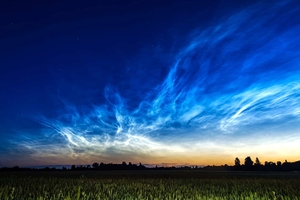White nights are ideal times for observing noctilucent clouds
Astronomical club “Asterion” continues to observe unusual celestial phenomena.
Members of the Astronomical Club “Asterion” witnessed a rare natural phenomenon – noctilucent clouds. Such clouds look like waves or ripples on water, and even through the densest of them stars are visible.
Vladimir Romanov, a member of the Astronomical Club “Asterion”, said:
The nights, although slightly longer, are still white. It is in the light sky that noctilucent clouds can be observed, so they are observed traditionally in the summer, at the time of white nights.
These are very high clouds and very thin. You can observe them when the Sun is below the horizon, but not very low. Although the Sun is below the horizon, since the clouds are very high, you can see it from them. The sun illuminates the noctilucent clouds below. And just in the daytime no silvery clouds are visible, tk. The sun is shining too brightly, and the light of these clouds is “lost” against its background. If, on the contrary, the Sun is very far below the horizon (deep night), then it is not visible from noctilucent clouds either (accordingly, they are not illuminated). The ideal time to observe noctilucent clouds is on a white night.
For reference:
Noctilucent clouds are the tallest cloud formations in the earth’s atmosphere, occurring at altitudes of 70-95 km. They are also called polar mesospheric clouds (PMC) or noctilucent clouds (NLC). These are light translucent clouds that are sometimes visible against the background of a dark sky on a summer night in mid and high latitudes.
They are believed to be composed of ice crystals that form on small dust particles from meteors. They can only form at incredibly low temperatures and when water is available to form ice crystals.
Why do these clouds, which require such low temperatures, form in the summer? All because of the dynamics of the atmosphere. In fact, at this altitude in the mesosphere in summer near the poles the lowest temperatures of the year.
Here’s how it works: In summer, the air near the ground heats up and rises. As atmospheric pressure decreases with altitude, the rising air expands. When this happens, it also cools down. This, along with other processes in the upper atmosphere, raises the air even higher, causing it to cool even more. As a result, the temperature in the mesosphere can drop to -134 ° C.
Because clouds are so sensitive to atmospheric temperatures, they give scientists more information about the wind circulation causing these temperatures.

